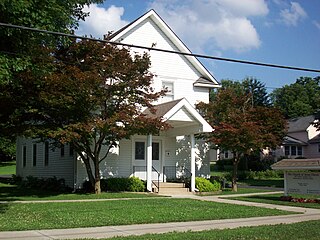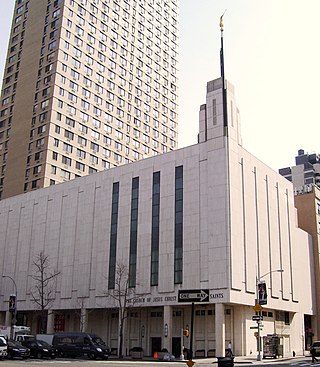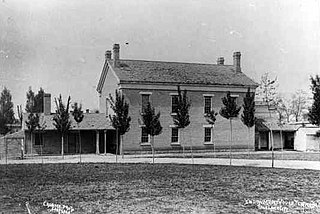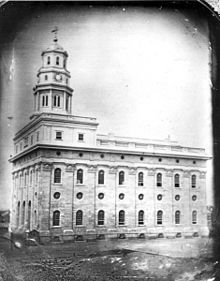
In Mormonism, the endowment is a two-part ordinance (ceremony) designed for participants to become kings, queens, priests, and priestesses in the afterlife. As part of the first ceremony, participants take part in a scripted reenactment of the Biblical creation and fall of Adam and Eve. The ceremony includes a symbolic washing and anointing, and receipt of a "new name" which they are not to reveal to others except at a certain part in the ceremony, and the receipt of the temple garment, which Mormons then are expected to wear under their clothing day and night throughout their life. Participants are taught symbolic gestures and passwords considered necessary to pass by angels guarding the way to heaven, and are instructed not to reveal them to others. As practiced today in the Church of Jesus Christ of Latter-day Saints, the endowment also consists of a series of covenants that participants make, such as a covenant of consecration to the LDS Church. All LDS Church members who choose to serve as missionaries or participate in a celestial marriage in a temple must first complete the first endowment ceremony.

The Church of Jesus Christ (Cutlerite) is a denomination of the Latter Day Saint movement headquartered in Independence, Missouri, United States. The church derives its epithet from its founder, Alpheus Cutler, a member of the Nauvoo High Council and of Joseph Smith's Council of Fifty. Cutler justified his establishment of an independent church organization by asserting that God had "rejected" Smith's organization—but not his priesthood—following Smith's death, but that Smith had named Cutler to a singular "Quorum of Seven" in anticipation of this event, with a unique prerogative to reorganize the church that no one beyond this group possessed. Hence, Cutler's organization claims to be the only legitimate Latter Day Saint church in the world today. Currently, it has only one branch, located in Independence. The Cutlerite church retains an endowment ceremony believed to date to the Nauvoo period, practices the United Order of Enoch, and accepts baptism for the dead, but not eternal marriage or polygamy.

The Latter Day Saint movement is a religious movement within Christianity that arose during the Second Great Awakening in the early 19th century and that led to the set of doctrines, practices, and cultures called Mormonism, and to the existence of numerous Latter Day Saint churches. Its history is characterized by intense controversy and persecution in reaction to some of the movement's doctrines and practices and their relationship to mainstream Christianity. The purpose of this article is to give an overview of the different groups, beliefs, and denominations that began with the influence of Joseph Smith.

Washing and anointing is a ritual purification ordinance, similar to chrismation, that is part of the temple endowment ceremony practiced by the Church of Jesus Christ of Latter-day Saints and Mormon fundamentalists.

The Salt Lake Temple is a temple of the Church of Jesus Christ of Latter-day Saints on Temple Square in Salt Lake City, Utah, United States. At 253,015 square feet (23,505.9 m2), it is the largest Latter-day Saint temple by floor area. Dedicated in 1893, it is the sixth temple completed by the church, requiring 40 years to complete, and the fourth temple built since the Mormon exodus from Nauvoo, Illinois, in 1846. The temple was closed in December 2019 for a general remodelling and seismic renovations, which were initially estimated to take approximately four years. Subsequent updates extended the estimated completion to 2026, for a total renovation timeline lasting an anticipated six or seven years.

The Nauvoo Illinois Temple is the 113th dedicated temple of the Church of Jesus Christ of Latter-day Saints. It is the third such temple that has been built in Illinois.

The Kirtland Temple is the first temple built by adherents of the Latter Day Saint movement. It is located in Kirtland, Ohio, United States, and was completed and dedicated in March 1836. Designed by Joseph Smith, the founder and original leader of the movement, the architecture mixes the Federal, Greek Revival, and Gothic Revival styles. The temple was added to the National Register of Historic Places in 1969 and named a National Historic Landmark in 1977. Prior to March 5, 2024, it was owned and operated by Community of Christ for more than a century. Since that date, it has been owned and operated by the Church of Jesus Christ of Latter-day Saints as a historic site open year-round for guided tours, meetings, and other programming.

In the Latter Day Saint movement, a temple is a building dedicated to being a house of God and is reserved for special forms of worship. A temple differs from a church meetinghouse, which is used for weekly worship services. Temples have been a significant part of the Latter Day Saint movement since early in its inception. Today, temples are operated by several Latter Day Saint denominations. The most prolific builder of temples of the Latter Day Saint movement is the Church of Jesus Christ of Latter-day Saints. The LDS Church has 350 temples in various phases, which includes 189 dedicated temples, 52 under construction, and 108 others announced. Several others within the movement have built or attempted to build temples. The Community of Christ operates one temple in the United States, which is open to the public and used for worship services, performances, and religious education. Other denominations with temples are the Apostolic United Brethren, the Church of Christ, the Fundamentalist Church of Jesus Christ of Latter-Day Saints, and the Righteous Branch of the Church of Jesus Christ of Latter-day Saints.
In temples of the Church of Jesus Christ of Latter-day Saints, an ordinance room is a room where the ceremony known as the Endowment is administered, as well as other ordinances such as Sealings. Some temples perform a progressive-style ordinance where patrons move from room to room, each room representing a progression of mankind: the Creation room, representing the Genesis creation story; the Garden room represents the Garden of Eden where Adam and Eve lived prior to the fall of man; the World room, where Adam and Eve lived after the fall; the Terrestrial room; and the Celestial room representing the Celestial Kingdom of God, or more commonly, heaven. There is also an additional ordinance room, the Sealing room, and at least one temple has a Holy of Holies. These two rooms are reserved for the administration of ordinances beyond the Endowment. The Holy of Holies is representative of that talked about when the temple is discussed in the bible.

The St. George Utah Temple, formerly known as the St. George Temple, is a temple of the Church of Jesus Christ of Latter-day Saints in St. George, Utah. Completed in 1877, it was the third temple constructed by the church and the first in Utah, following the westward migration of members from Nauvoo, Illinois, after the death of church founder Joseph Smith.

The Columbus Ohio Temple is a temple of the Church of Jesus Christ of Latter-day Saints located in Columbus, Ohio, United States. It was completed and dedicated in 1999 as the church's 60th operating temple and serves church members living in 16 stakes, covering most of Ohio, but also extending into western Pennsylvania and southwestern West Virginia. The temple is in the western edge of Columbus, adjacent to Interstate 270 just north of its western junction with I-70.

The Manhattan New York Temple is the 119th operating temple of the Church of Jesus Christ of Latter-day Saints. It is the second "high rise" LDS temple to be constructed, after the Hong Kong China Temple, and the third LDS temple converted from an existing building, the previous two being the Vernal Utah Temple and the Copenhagen Denmark Temple.

The Endowment House was an early building used by the Church of Jesus Christ of Latter-day Saints to administer temple ordinances in Salt Lake City, Utah Territory. From the construction of the Council House in 1852, Salt Lake City's first public building, until the construction of the Endowment House, the members of the LDS Church used the top floor of the Council House for administering temple ordinances. When this arrangement proved impractical, Brigham Young directed Truman O. Angell, architect of the Salt Lake Temple, to design a temporary temple. Completed in 1855, the building was dedicated by Heber C. Kimball and came to be called the Endowment House after the endowment ceremonies that were conducted inside it.

On December 27, 1832, two years after the organization of the Church of Christ, the movement's founder, Joseph Smith, stated he received a revelation that called upon church members to restore the practice of temple worship. The Latter Day Saints in Kirtland, Ohio were commanded to:
"Establish a house, even a house of prayer, a house of fasting, a house of faith, a house of learning, a house of glory, a house of order, a house of God."

The Plano Stone Church was constructed in 1868 to serve as the headquarters for the Reorganized Church of Jesus Christ of Latter Day Saints under the leadership of Joseph Smith III. Smith moved to Plano, Illinois, in 1866 and in 1867 was appointed head of the Stone Church's building committee. Smith and the committee selected the site, design and builder for the structure. The Plano Stone Church served as the headquarters of the RLDS from its completion in 1868 until Smith, his family, and the church moved to Lamoni, Iowa, in 1881.

In the Church of Jesus Christ of Latter-day Saints, a temple is a building dedicated to be a House of the Lord. Temples are considered by church members to be the most sacred structures on earth.
In the theology of the Latter Day Saint movement, an endowment refers to a gift of "power from on high", typically associated with the ordinances performed in Latter Day Saint temples. The purpose and meaning of the endowment varied during the life of movement founder Joseph Smith. The term has referred to many such gifts of heavenly power, including the confirmation ritual, the institution of the High Priesthood in 1831, events and rituals occurring in the Kirtland Temple in the mid-1830s, and an elaborate ritual performed in the Nauvoo Temple in the 1840s.

The following outline is provided as an overview of and a topical guide to the Church of Jesus Christ of Latter-day Saints.
The architecture of the Church of Jesus Christ of Latter-day Saints includes the design and use of the church's temples, meetinghouses, historic sites, and other buildings and facilities. The LDS Church is known for its unique and often imposing architecture. The church's architecture differs based on the uses of individual buildings and varies in style throughout the world.

In the Church of Jesus Christ of Latter-day Saints —Mormonism's largest denomination—there have been numerous changes to temple ceremonies over time in the church's over-200-year history. Temples are not churches or meetinghouses designated for public weekly worship services, but rather sacred places that only admit members in good standing with a recommendation from their leaders. LDS Church members perform rituals within temples. They are taught that God has deemed these ordinances as essential to achieving the faith's ultimate goal after death of exaltation. They are also taught that a vast number of dead spirits exist in a condition termed spirit prison for whom when the temple ordinances are completed will have the option to accept the ordinances and be freed of their imprisonment. These temple ordinances are performed by a living church member for themself and "on behalf of the dead" or "by proxy".

































